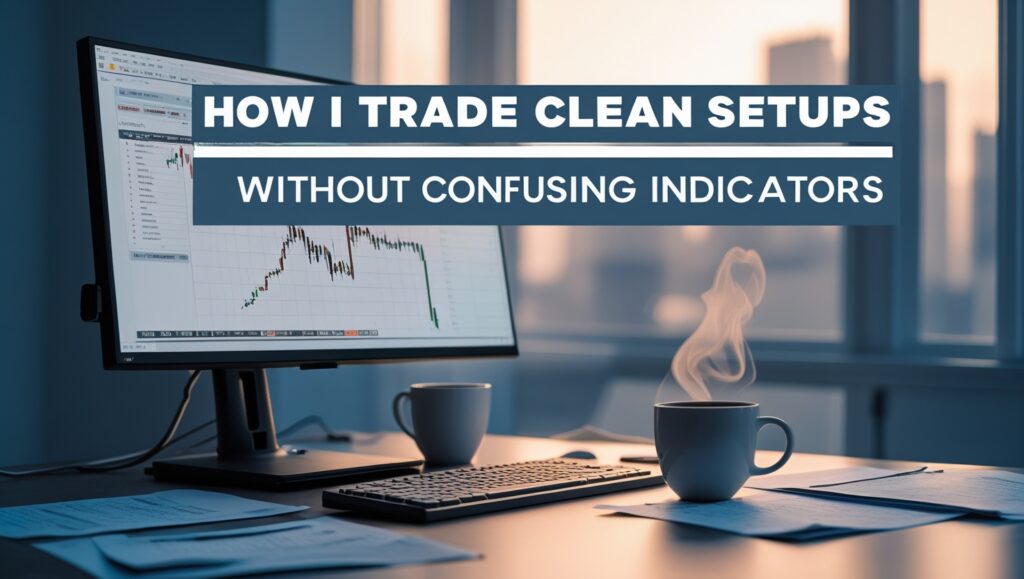How I Trade Clean Setups Without Confusing Indicators
How I Trade Clean Setups Without Confusing Indicators
When I first started trading, I thought I needed ten different indicators on my chart just to feel “prepared.” I used to stack RSI, MACD, Bollinger Bands, EMAs, VWAP — and honestly, I was more confused than confident. The screen was a mess. And worse? My results were inconsistent.
So I stopped. I cleared my chart. I went back to the basics. Now I focus on clean price action setups, and I haven’t looked back since.

Table of Contents
Trading Got Easier When I Removed the Noise
What helped me wasn’t learning more indicators — it was learning what mattered. I realized the market moves because of buyers and sellers, not because a line crossed another line on an indicator.
So I started focusing on price action, volume, and key support/resistance levels. That’s it. No lagging indicators. No conflicting signals. Just structure and flow. Once I simplified my charts, my confidence grew, and my execution improved.
Clean Charts Give Me a Clear Mind
When you remove the clutter from your charts, your thinking clears up too. I could finally see where price was reacting, consolidating, or breaking out — without a dozen signals contradicting each other.
I began spotting patterns earlier and stopped second-guessing myself. That alone made a massive difference in my win rate and how calm I felt while trading.
What I Use Now (And What I Don’t)
Let me be real: I’m not against indicators. Some traders use them well. But for my strategy, I don’t need them.
I stick to:
- Price action: Candles tell me everything — who’s in control, where momentum is, and if buyers are stepping in.
- Volume: I want to see confirmation behind the move. Is there commitment? Or is it just noise?
- Key levels: I map out areas of interest based on past reactions and volume zones. These are my zones to strike.
What I don’t use anymore:
- RSI, MACD, Stochastics — they lag and often conflict with each other.
- Fancy color-coded indicators that promise the moon.
- Automated signals or paid alerts. I trust my own analysis now.
My Simpler Strategy Pays My Bills
I’ve built a system that works for me — one that doesn’t require constant alerts, complex software, or following someone else’s trades. I focus on a few clean setups each week, and I know exactly what I’m looking for.
If you want to learn how I do it, I put everything into my ebook. It’s called:
In it, I walk you through how I find clean setups, how I build my watchlist, and how I use price and volume to enter high-probability trades — without relying on messy charts or indicators that lie.
Final Thoughts
Don’t fall for the idea that more tools = more success. In my experience, less is more. Once I stripped my strategy down to the essentials, my results got better, my confidence grew, and my screen-time dropped.
If you’re overwhelmed by all the indicators and still not getting results, try simplifying. Clean charts, clear setups, and strong risk management can take you much further than you think.
One of the biggest breakthroughs I had was realizing that indicators don’t predict anything — they just respond to what already happened. They’re lagging tools. By the time RSI shows “overbought,” the move may be halfway done. That delay was costing me entries and creating hesitation.
Another issue with stacking indicators is they often contradict each other. I’d see RSI say one thing, MACD say another, and volume give a third signal. That confusion would paralyze me. And in trading, hesitation is deadly. Clean setups don’t require constant second-guessing.
Once I cleaned up my chart, I actually started seeing the story behind the candles. Where did buyers step in? Where did sellers defend? What levels have been tested multiple times? Those things matter more than whether a line crosses above or below a threshold.
I also noticed that price respects clean levels more often than random indicators. Support and resistance drawn based on real price action give you better entries and tighter stops. They’re not perfect, but they’re clearer and easier to manage.
Another benefit? I traded less but made more. When your setup is clean and clear, you wait patiently. You don’t force trades just because an indicator flashes green. You become more selective — and that’s where the edge is.
I started spending more time planning than clicking. Instead of staring at five indicators, I’d map out zones, watch how price reacts to them, and plan my entry and exit in advance. That shift made me feel in control — not at the mercy of signals.
Clean setups also helped me trust myself. Before, I was relying on tools that didn’t know my strategy or risk tolerance. Now, I trust my eyes, my process, and my discipline. And that kind of trust doesn’t come from fancy tools — it comes from time and simplicity.
Even my stress levels went down. There’s something powerful about opening your chart and seeing only what matters. No blinking arrows. No conflicting zones. Just pure structure. That calmness helped me stay focused and less reactive when things didn’t go my way.
I get a lot of DMs asking, “What indicators do you use?” My answer surprises most people: none. And yet, I’ve been able to grow a small account and pay my bills just by trading key setups I trust. If you’re curious how I do it, it’s all inside my ebook.
Again, here’s the link:
👉 Pay Your Bills with Stocks
It’s a simple breakdown of my real trading system — no hype, no fluff, just how I trade and why it works for me.
One last thing: I’m not here to bash indicators completely. If they help you build a system you trust, that’s great. But if you’re like I was — overwhelmed and confused — try removing them for a while. You might be surprised what you start to notice.
You don’t need to trade like everyone else. You just need a process that fits your personality and goals. For me, that meant trading clean setups — no noise, no clutter, just confidence.

Stay ahead in the stock market! Subscribe to our newsletter and receive exclusive stock flow reports, trading insights, and actionable tips directly in your inbox. Join thousands of traders who get our updates first.







